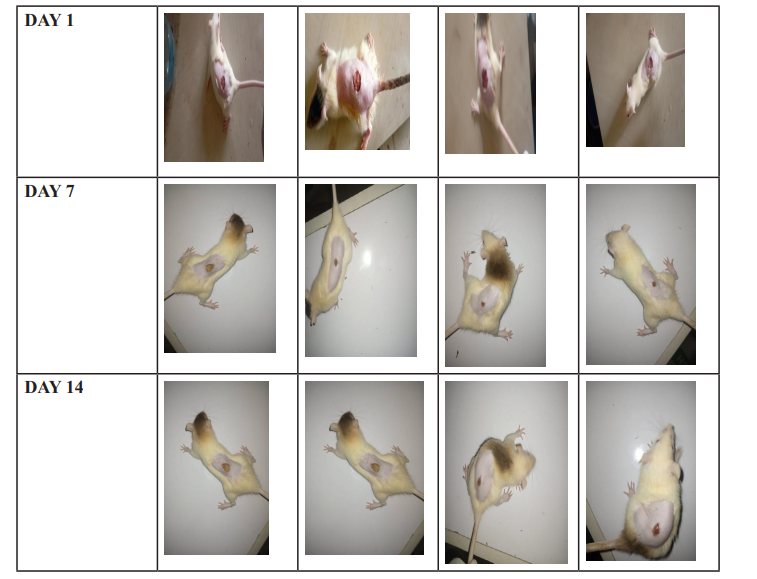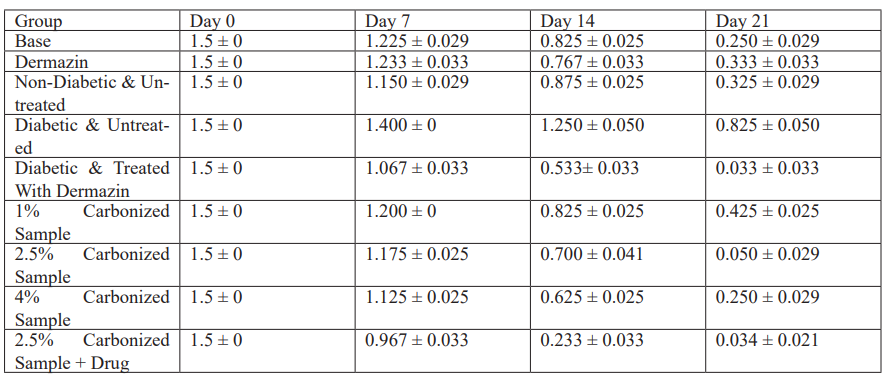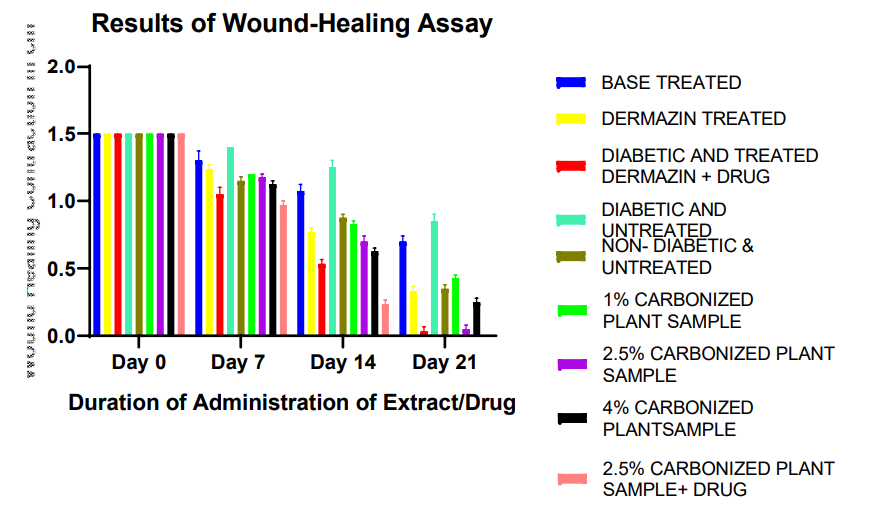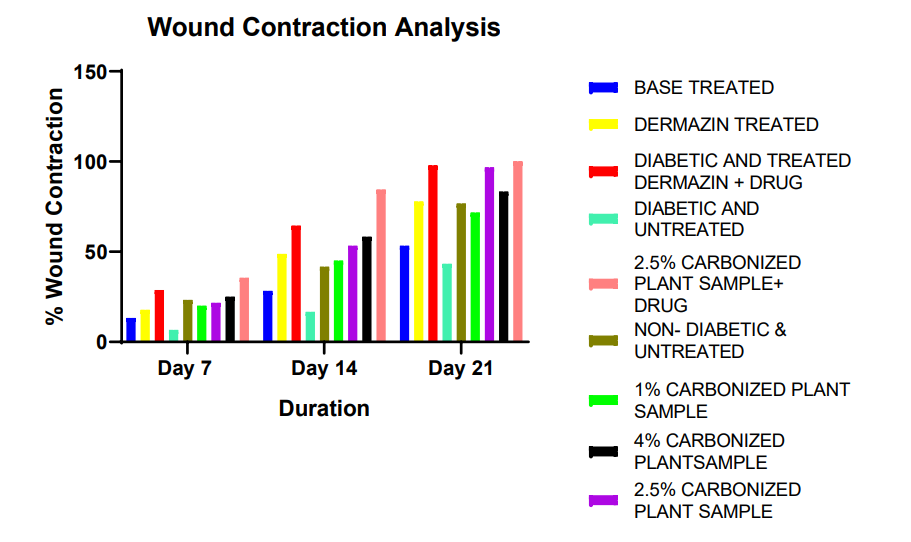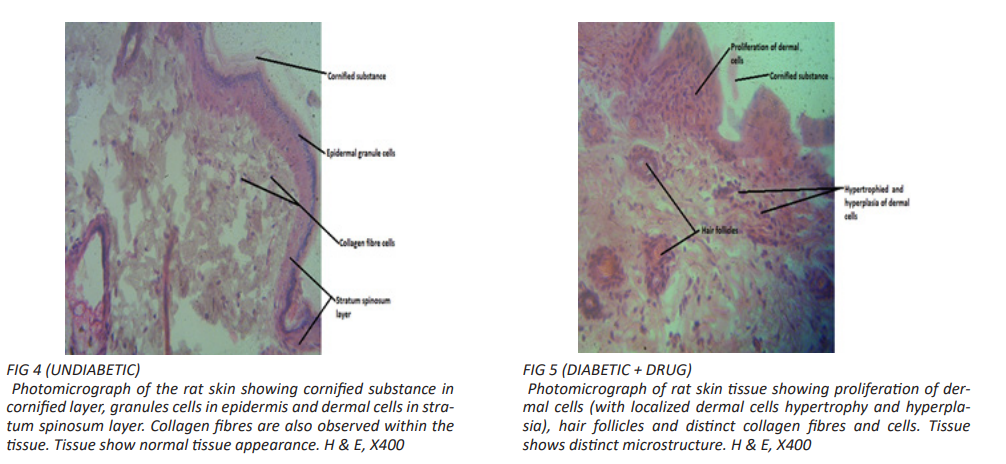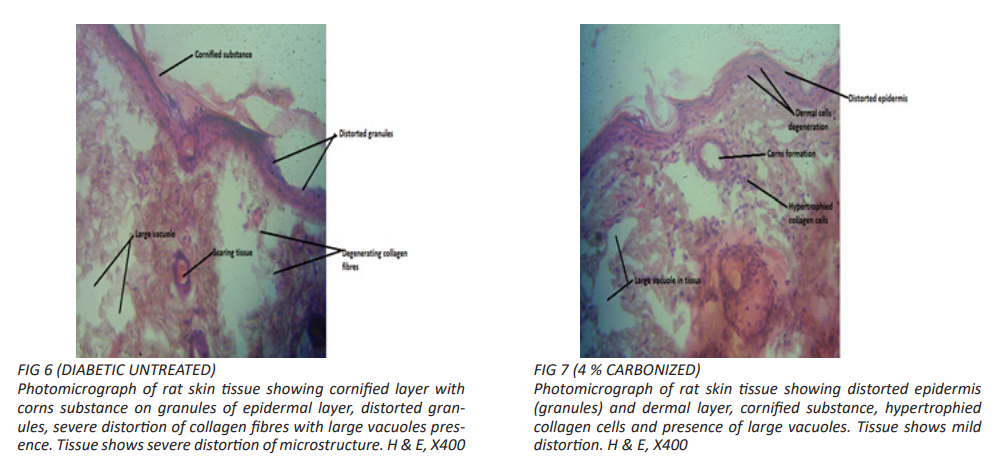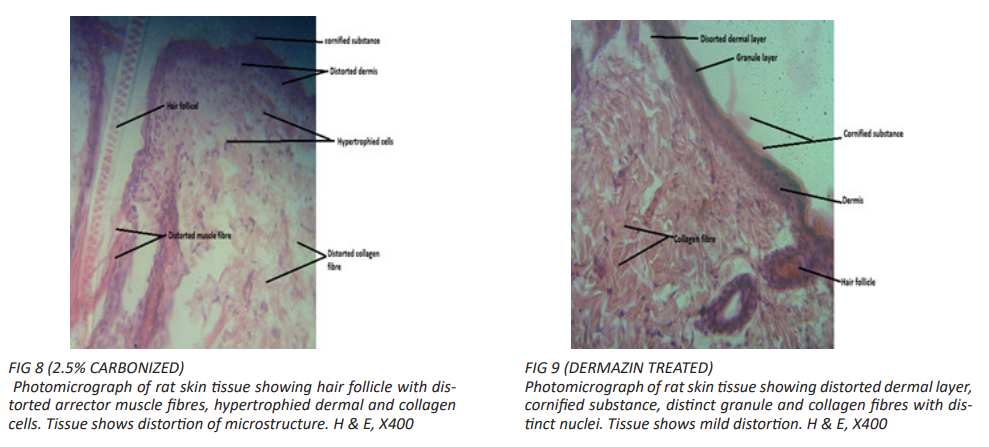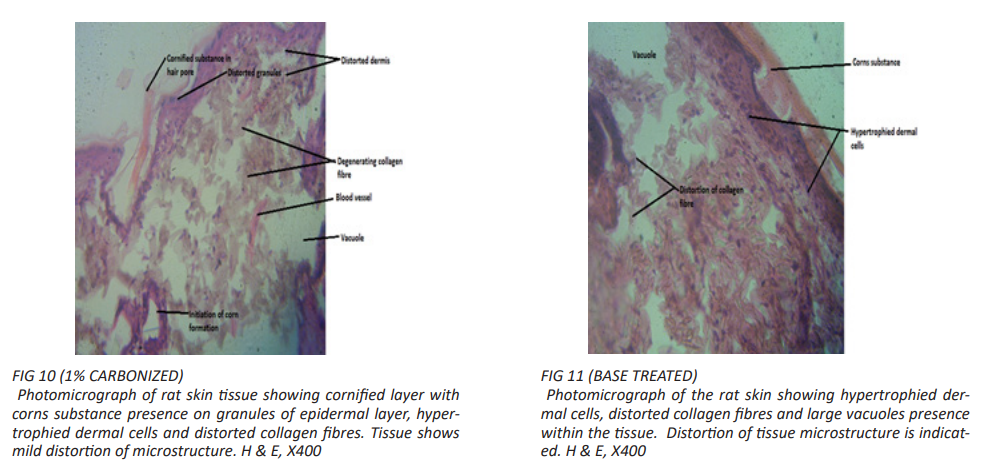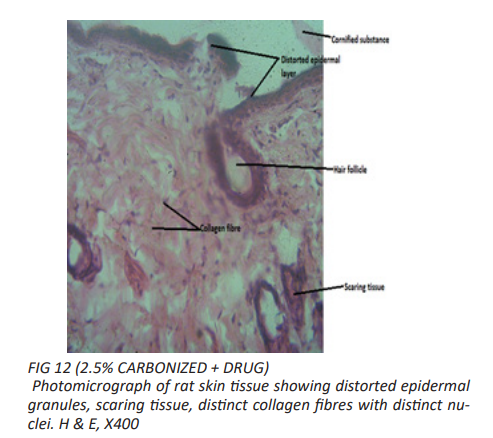EVALUATION OF THE WOUND HEALING EFFECT OF THE CARBONIZED SEED POD OF PENTACLETHRA MACROPHYLLA BENTH IN DIABETIC FOOT ULCER
Jegede Olusegun Samuel1,Johnson-Ajinwo, Okiemute Rosa2* and Oghenebor, Gabriel Onoriode3
1Department of Pharmaceutical/Medicinal Chemistry, Faculty of Pharmaceutical Sciences, University of Port Harcourt, Nigeria
ORCID ID: 0009-0002-4427-1294
2Department of Pharmaceutical/Medicinal Chemistry, Faculty of Pharmaceutical Sciences, University of Port Harcourt, Nigeria
ORCID ID: https://orcid.org/0000-0002-6157-066X
3Department of Pharmaceutical/Medicinal Chemistry, Faculty of Pharmaceutical Sciences, University of Port Harcourt, Nigeria
*Corresponding author
*Johnson–Ajinwo, O. Rosa., Department of Pharmaceutical/Medicinal Chemistry, Faculty of Pharmaceutical Sciences, University of Port Harcourt, Nigeria
Table 1: Showing physicochemical parameters of the seed pod of Pentaclethra macrophylla Benth.
Figure 1: Wound contraction of different test groups on Days 1, 7 and 14.
Table 2: Table showing the blood sugar readings of the various groups, before induction, after induction, and on Days 7 and 14.
Table 3: Showing the mean and standard error of mean, of the wound contraction in centimeters (cm) on Days 7, 14 and 21.
Figure 2: Chart showing wound contraction in centimeters (cm) for control (Based treated, dermazin treated, diabetic and treated with dermazin plus drug, diabetic and untreated, non-diabetic and untreated, and test group (1% carbonized plant sample, 2.5% carbonized plant sample, 4% carbonized plant sample, 2.5% carbonized plant sample plus drug).
Figure 3: Chart of wound contraction in percentage (%) for control group (Based treated, dermazin treated, diabetic and treated with dermazin plus drug, diabetic and untreated, non-diabetic and untreated and test group (1% carbonized plant sample, 2.5% carbonized plant sample, 4% carbonized plant sample, 2.5% carbonized plant sample plus drug).
Figures 4 & 5
Figures 6 & 7
Figures 8 & 9
Figures 10 & 11
Figures 12: (2.5% CARBONIZED + DRUG) Photomicrograph of rat skin tissue showing distorted epidermal granules, scaring tissue, distinct collagen fibres with distinct nuclei. H & E, X400.
- Cho NH, Shaw JE, Karuranga S, Huang Y, da Rocha Fernandes JD, et al. (2018) IDF Diabetes Atlas: Global estimates of diabetes prevalence for 2017 and projections for 2045. Diabetes Research and Clinical Practice 138: 271-281.
- Mieczkowski M, Mrozikiewicz-Rakowska B, Kowara M, Kleibert M, Czupryniak L (2022) The Problem of Wound Healing in Diabetes—From Molecular Pathways to the Design of an Animal Model. International Journal of Molecular Sciences 23(14).
- Jiang P, Li Q, Luo Y, Luo F, Che Q, et al. (2023). Current status and progress in research on dressing management for diabetic foot ulcer. Frontiers in Endocrinology 14: 1221705.
- Clayton WJr, Elasy TA (2009) A review of the pathophysiology, classification, and treatment of foot ulcers in diabetic patients. Clinical Diabetes.
- Brem, Harold, Tomic-Canic, Marjana (2007) Cellular and molecular basis of wound healing in diabetes. The Journal of Clinical Investigation 117(5): 1219-1222.
- Armstrong DG, Boulton AJ, Bus SA (2017) Diabetic foot ulcers and their recurrence. The New England Journal of Medicine 376(24): 2367-2375.
- Walsh JW, Hoffstad OJ, Sullivan MO, Margolis DJ (2016) Association of diabetic foot ulcer and death in a population-based cohort from the United Kingdom. Diabetic Medicine 33(11): 1493-1498.
- Goodridge D, Trepman E, Sloan J, Reid G, Embil J (2005) Quality of life of adults with unhealed and healed diabetic foot ulcers. Foot & Ankle International 26(11): 899-910.
- Kim J, Nomkhondorj O, An CY, Choi YC, Cho J (2023) Management of diabetic foot ulcers: A narrative review. Journal of Yeungnam Medical Science 40(4): 335-342.
- Soepadmo E (2016) Pentaclethra macrophylla: A traditional wound healing plant. Journal of Ethnopharmacology.
- Okorie CC, Oparaocha ENT, Adewunmi CO, Iwalewa EO, Omodara SK (2006) Anti-inflammatory and cytotoxic activities of Pentaclethra macrophylla aqueous extracts in mice. African Journal of Traditional, Complementary and Alternative Medicines, 3(1): 44-53.
- Oyejide SO, Nwinyi O, Oniha MI, Olugbuyiro J, Taiwo O (2022) Antibacterial activities of Pentaclethra macrophylla and Syzygium samarangense against opportunistic bacterial pathogens. International Journal of Advances in Life Science and Technology 6(1): 24-30.
- Nwagwe OR, Eze AC, Nweke EJ (2024) Exploring the therapeutic potential of Pentaclethra macrophylla in diabetic wound management. Journal of Ethnopharmacology, 295: 115326.
- AOAC (1990) Association official Analytical chemists. 15th edn. Wash. Dc, U.S.A.
- Kim M (2024) Induction of Diabetes Mellitus Using Alloxan in Sprague Dawley Rats. Cureus 16(6).
- Samanta R, Pattnaik AK, Pradhan KK, Mehta BK, Pattanayak SP, et al. (2016) Wound Healing Activity of Silibinin in Mice. Pharmacognosy Research 8(4): 298-302.
- Quazi A, Patwekar M, Patwekar F, Mezni A, Ahmad I, (2022) Evaluation of Wound Healing Activity (Excision Wound Model) of Ointment Prepared from Infusion Extract of Polyherbal Tea Bag Formulation in Diabetes-Induced Rats. Evidence-Based Complementary and Alternative Medicine: ECAM.
- Slaoui M, Bauchet AL, Fiette L (2017) Tissue sampling and processing for histopathology evaluation. Methods in Molecular Biology pp. 1641.
- Chandel HS, Pathak AK, Tailang M (2011) Standardization of some herbal antidiabetic drugs in polyherbal formulation. Pharmacognosy Research 3(1): 49-56.
- Boulton AJ, Vileikyte L, Ragnarson-Tennvall G, Apelqvist J (2005) The global burden of diabetic foot disease. Lancet 366: 9498.
- Wilkinson HN, Hough LM, Schupp, M, Trowbridge, AS (2020) The role of inflammation in wound healing. Journal of Wound Care 29(10): 542-550.


